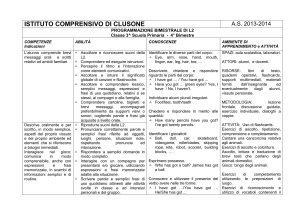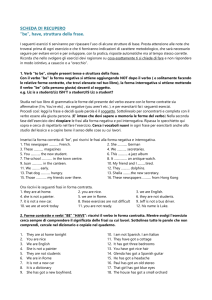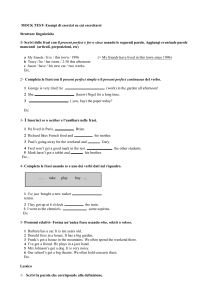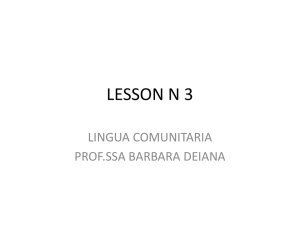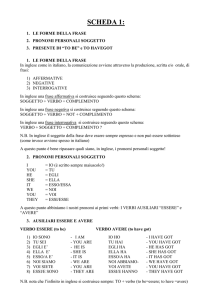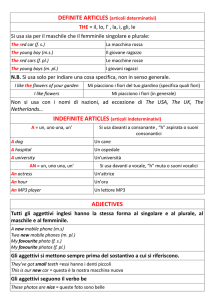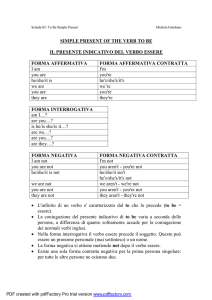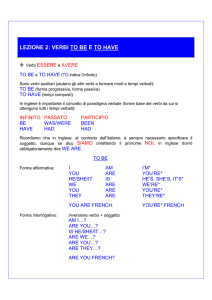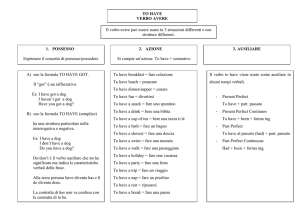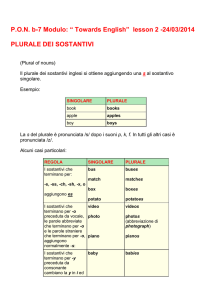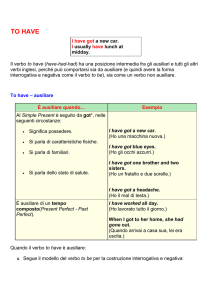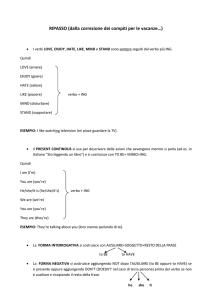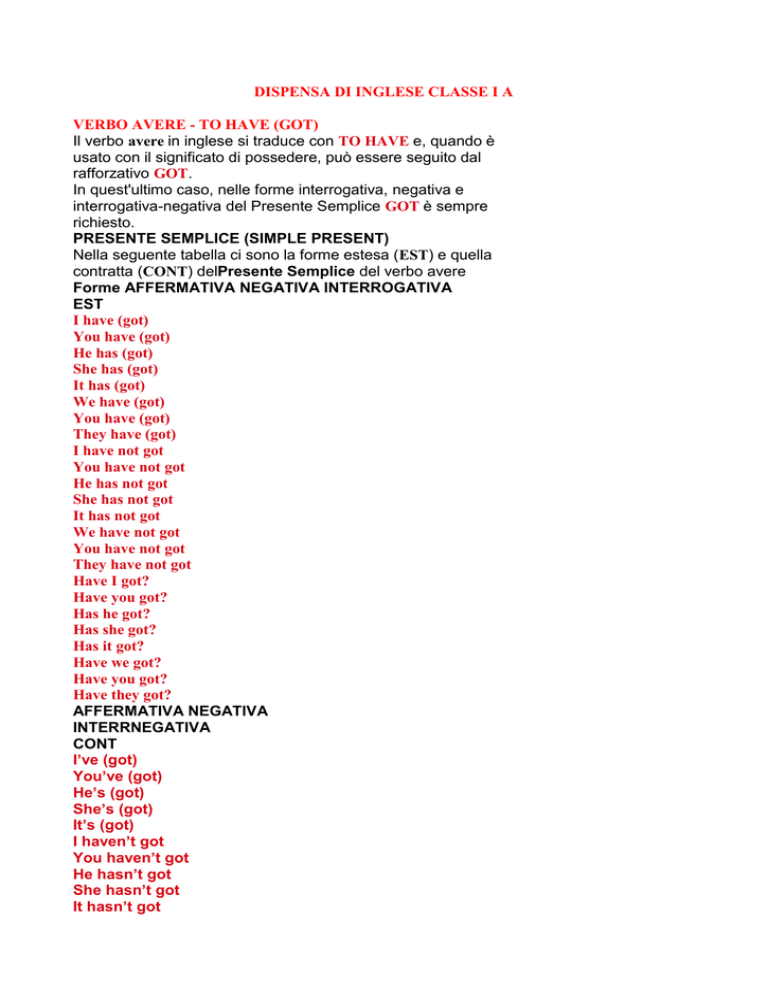
DISPENSA DI INGLESE CLASSE I A
VERBO AVERE - TO HAVE (GOT)
Il verbo avere in inglese si traduce con TO HAVE e, quando è
usato con il significato di possedere, può essere seguito dal
rafforzativo GOT.
In quest'ultimo caso, nelle forme interrogativa, negativa e
interrogativa-negativa del Presente Semplice GOT è sempre
richiesto.
PRESENTE SEMPLICE (SIMPLE PRESENT)
Nella seguente tabella ci sono la forme estesa (EST) e quella
contratta (CONT) delPresente Semplice del verbo avere
Forme AFFERMATIVA NEGATIVA INTERROGATIVA
EST
I have (got)
You have (got)
He has (got)
She has (got)
It has (got)
We have (got)
You have (got)
They have (got)
I have not got
You have not got
He has not got
She has not got
It has not got
We have not got
You have not got
They have not got
Have I got?
Have you got?
Has he got?
Has she got?
Has it got?
Have we got?
Have you got?
Have they got?
AFFERMATIVA NEGATIVA
INTERRNEGATIVA
CONT
I’ve (got)
You’ve (got)
He’s (got)
She’s (got)
It’s (got)
I haven’t got
You haven’t got
He hasn’t got
She hasn’t got
It hasn’t got
Haven't I got?
Haven't you got?
Hasn't he got?
Hasn't she got?
Hasn't it got?
We’ve (got)
You’ve (got)
They’ve (got)
We haven’t got
You haven’t got
They haven’t
got
Haven't we got?
Haven't you got?
Haven't they got?
RISPOSTE BREVI (SHORT ANSWERS)
Nelle risposte brevi, dopo "Yes" o "No" si usa sempre il pronome personale e poi, a seconda
della persona soggetto,HAVE o HAS e non si usa mai il GOT.
Have you got a pen? -Yes, I have/No, I haven't = Hai una penna? Sì/No
Has Jane got a pen? -Yes, she has/No, she hasn't = Jane ha una penna? Sì/No
1. Put the verb to have got into the empty spaces
Hi, my name is Jane. I got one sister, Mary, and one brother, John.
Mary got a lot of friends. She studies English and got a computer to
browse the Internet. John is a mechanic, he got a new car. I don't like cars,
but
I got a bike. Mary, John and I got a nice cottage: it got three
bedrooms. We got two pets, one cat and one dog.
AGGETTIVI E PRONOMI POSSESSIVI
Aggettivi Possessivi
Gli aggettivi possessivi sono sempre seguiti da un sostantivo:
Questo è il mio libro.
• mio = aggettivo possessivo
• libro = sostantivo
In italiano si concordano con il sostantivo a cui si riferiscono. Esempi:
Il mio libro
La mia amica
I miei libri
Le mie amiche
In inglese sono invariabili e non sono mai preceduti dall’articolo. Esempi:
Il mio libro My book
I miei libri My books
Mia sorella My sister
Le mie sorelle My sisters
Pronomi Possessivi
I pronomi possessivi non sono seguiti da un sostantivo, ma lo sottintendono:
Questo libro è mio.
• Mio è un pronome possessivo: sottintende il sostantivo libro.
In inglese sono invariabili e non sono mai preceduti da articolo.
This book is mine
These books are mine
È importante distinguere i pronomi dagli aggettivi possessivi, perché in inglese hanno a
volte forme
diverse.
Pronomi Personali
Soggetto
Aggettivi Possessivi Pronomi Possessivi
I Io my
mio, mia,
miei, mie
mine
il mio, la mia,
i miei, le mie
you tu your tuo, tua, yours il tuo, la tua,
tuoi, tue i tuoi, le tue
he egli/lui his
suo, sua,
suoi, sue
his
il suo, la sua
i suoi, le sue
she ella/lei her
suo, sua,
suoi, sue
hers
il suo, la sua
i suoi, le sue
it esso/essa its
suo, sua,
suoi, sue
its*
il suo, la sua
i suoi, le sue
we Noi our
nostro, nostra,
nostri,nostre
ours
il nostro, la nostra,
i nostri, le nostre
you Voi your
vostro, vostra, vostri,
vostre
yours
il vostro, la vostra, i
vostri, le vostre
they essi/esse their loro theirs
il loro, la loro,
i loro, le loro
* come pronome possessivo, in pratica, non è usato
Gli aggettivi e pronomi possessivi di 3° persona singolare si riferiscono al possessore :
• HIS suo/sua/suoi/sue di lui, riferito a persone maschili.
Esempi:
Mark e suo padre Mark and his father
Mark e sua madre Mark and his mother
Mark e i suoi amici Mark and his friends
• HER / HERS suo/sua /suoi/sue di lei, riferito a persone femminili. Esempi:
Susan e suo padre Susan and her father
Susan e sua madre Susan and her mother
Susan e i suoi amici Susan and her friends
• ITS riferito a cose o animali
Aggettivi e Pronomi possessivi e articolo
In inglese si usano gli aggettivi possessivi al posto dell’articolo determinativo quando ci si
riferisce
a parti del corpo. Esempi:
Mi lavo le mani--> Lavo le mie mani --> I wash my hands.
Gli taglio i capelli--> Taglio i suoi capelli--> I cut his hair.
In inglese l’articolo che si sottintende davanti ad aggettivi e pronomi possessivi è sempre
l’articolo
determinativo THE. Esempio:
My friend --> (the) my friend --> il mio amico.
Se voglio dire “un mio amico”, non posso far precedere l’aggettivo possessivo
dall’articoloA,
perché nessun articolo può mai precedere aggettivi e pronomi possessivi, né posso dire
semplicemente “my friend” perché l’articolo sottinteso è THE. Perciò devo ricorrere ad una
costruzione alternativa:
Un mio amico --> Un amico dei miei --> A friend of mine
Marta e un suo amico --> Marta e un amico dei suoi --> Martha and a friend ofhers
1. ESERCIZIO SUGLI AGGETTIVI POSSESSIVI BEGINNERS GB
Write the correct possessive adjective for each sentence
1) I've got (he) pen.
I've got his pen.
2) (she) dog's name is Bobby.
Her dog's name is Bobby.
3) What's (he) name?
What's his name?
4) I've never met (I) brother's girlfriend.
I've never met my brother's girlfriend.
5) Have you met (they) new teacher?
Have you met their new teacher?
6) I like (you) shoes.
I like your shoes.
7) (I) friends go to the cinema on Fridays.
My friends go to the cinema on Fridays.
8) She didn't want to go to she) friend's party.
She didn't want to go to her friend's party.
9) They celebrated with (they) friends.
They celebrated with their friends.
10) The bird was suffering because one of (it) wings was broken.
The bird was suffering because one of its wings was broken.
2. SU AGGETTIVI E PRONOMI POSSESSIVI
Write the correct possessive adjective or pronoun in each sentence
1) (they) house is bigger than (you).
Their house is bigger than yours.
2) Mary’s bike is next to (he).
Mary’s bike is next to his.
3) I don’t know (she) point of view but I know (my).
I don’t know her point of view but I know mine.
4) These are some friends of (I).
These are some friends of mine.
5) Has she seen (you) new car?
Has she seen your new car?
6) I didn’t know that was (he) mother.
I didn’t know that was his mother.
7) I think this is (I) bag. Oh, no, it’s (you).
I think this is my bag. Oh, no, it’s yours.
8) They saw (I) aunt yesterday. She was with (she) friend Laura.
They saw my aunt yesterday. She was with her friend Laura.
9) Thomas bought some flowers for (she). It was (she) birthday.
Thomas bought some flowers for her. It was her birthday.
10) (I) cats were in the kitchen, waiting for (they) dinner.
My cats were in the kitchen, waiting for their dinner.
3. ESERCIZIO DI RICOSTRUZIONE
Make correct sentences from the words provided and then write the possessive adjective or
pronoun contained in each sentence
1) working in when she they was her called garden
She was working in her garden when they called. HER
2) competition to win our dog is going the.
Our dog is going to win the competition. OUR
3) Rose to hers with the of went cinema a friend yesterday
Rose went to the cinema with a friend of hers yesterday. HERS
4) dictionary that your table English is on
Your English dictionary is on that table. YOUR
5) mine red yours pen is or that?
Is that red pen mine or yours? MINE, YOURS
6) remember his you did birthday?
Did you remember his birthday? HIS
7) Is your it’s that car No, hers?
Is that your car? No, it’s hers. YOUR, HERS
8) met they of my a friend sister with yesterday hers who was
Yesterday they met my sister who was with a friend of hers. MY, HERS
9) ago Ted his car bought two months
Ted bought his car two months ago. HIS
10) old mine these books black are exercise
These
oldGENITIVO SASSONE
La costruzione inglese del genitivo sassone esprime una relazione di appartenenza che
può
riguardare:
SITUAZIONE ESEMPIO
Persone, espresse da nome proprio o
comune
La casa di Martha
La casa di mia sorella
La festa del papà
Animali Il nido dell’aquila
Espressioni di tempo Il giornale di oggi
Nazioni o città I parchi di New York
Il genitivo sassone si costruisce secondo il seguente schema:
POSSESSORE + ’S + COSA POSSEDUTA
Esempio:
SITUAZIONE ITALIANO INGLESE
Persone, espresse da
nome proprio o
comune
• La casa di Martha
• La casa di mia sorella
• La festa del papà
Martha’s house
My sister’s house
Father’s day
Animali Il nido dell’aquila The eagle’s nest
Espressioni di tempo Il giornale di oggi Today’s newspaper
Nazioni o città I parchi di New York New York’s parks
I sostantivi plurali che terminano per s prendono solo l’apostrofo:
ITALIANO INGLESE
L’appartamento degli studenti The students’ flat
I nomi propri che terminano per s possono prendere sia ‘s che il solo apostrofo.
ITALIANO INGLESE
L’auto del Sig. Jones Mr. Jones’s car
oppure
Mr. Jones’ car
Nella costruzione del genitivo sassone si possono sottintendere i seguenti sostantivi:
SOSTANTIVO ITALIANO INGLESE
House (casa) C’è una festa a casa di Mark There’s a party at Mark’s
house
Oppure:
There’s a party atMark’s.
Shop (negozio) Devo andare dal panettiere I must go to the baker’s(shop)
Office (ufficio) È nell’ufficio del commercialista He is at
theaccountant’s (office)
Surgery(ambulatorio) Sto andando dal dentista I’m going to
thedentist’s (surgery)
Church (chiesa)
Cathedral(cattedrale)
La cattedrale di St. Paul St. Paul’s (cathedral)
Uso dell’articolo con il genitivo sassone
Per l’uso dell’articolo con il genitivo sassone, tenere presente le seguenti regole:
REGOLA ITALIANO INGLESE
Non si
mette mail’articolo primadella
cosa posseduta (cioè
dopo ‘s).
Il libro dell’insegnante
L’ambulatorio del dottore
The teacher’s book
The doctor’s surgery
I nomi propri, gli aggettivi
possessivi, gli avverbi di
tempo e i titoli di cortesia
non possono mai essere
preceduti da articolo (vedi
capitoli "Articolo
Determinativo" e "Aggettivi
Possessivi").
Il libro del mio insegnante
L’ambulatorio del Dott.
Smith
My teacher’s book
(l’aggettivo possessivo non
vuole l’articolo)
Dr. Smith’s surgery
(non si mette l’articolo
davanti ai titoli di cortesia)
Quando non si può
esprimere l’articolo, si
sottintende sempre l’articolo
"the"
L’amico di mia sorella My sister’s friend
Se si vuole utilizzare
l’articolo
indeterminativoa/an occorre
modificare la costruzione
Un amico di mia sorella A friend of my
sister’s(letteralmente: un
amico di quelli di mia
sorella)
NOTA
Se si vuole esprimere una relazione di appartenenza con sostantivi che non rientrano nella
costruzione del genitivo sassone, si possono utilizzare due costruzioni:
REGOLA ITALIANO INGLESE
Utilizzare la
preposizione of
La copertina del libro The cover of the book
Utilizzare la
costruzione degli
aggettivi (vedi
capitolo "Uso e ruolo
degli aggettivi")
La copertina del libro The book cover
1. Transform the sentences using the possessive case
1) The books of your friends are on the table.
Your friends’ books are on the table.
2) The sons of Robert and Sam were playing together.
Robert’s and Sam’s sons were playing together.
3) We don’t remember the names of your friends.
We don’t remember your friends’
names.
4) The books of the sons of Ray are on the table.
Ray’s sons’ books are on the table.
5) The friendship of Dan and John was very strong.
Dan and John’s friendship was very strong.
6) That was the car of the parents of George.
That was George’s parents’ car.
7) The name of that old man is Philip.
That old man’s name is Philip.
8) The boys in the garden of my parents are my best friends.
The boys in my parents’ garden are my best friends.
9) They went to the cinema with the neighbour of my mother.
They went to the cinema with my mother’s neighbour.
10) They gave him a holiday of a week.
blacARTICOLO DETERMINATIVO
The
Articolo determinativo inglese, che corrisponde agli articoli italiani:
• il, lo, la, i, gli, le, l’
The resta invariato, a prescindere dal genere e dal numero del sostantivo che
accompagna.
Esempi:
Il ragazzo The boy
I ragazzi The boys
La ragazza The girl
Le ragazze The girls
The viene pronunciato "the" (dhë) quando la parola che segue inizia per
consonante o per acca aspirata*.
Esempi:
The book
The house
Viene invece pronunciato "thi" (dhi) quando la parola che segue inizia per vocale
o per acca muta*.
Esempi:
The apple
The hour
L’articolo THE non si usa:
REGOLA ITALIANO INGLESE
Davanti ai nomi
propri di nazione.
La Francia
L’Inghilterra
France
England
Davanti ad aggettivi
e pronomi
Il mio libro
È il mio
My book
It is mine
possessivi.
Davanti ai titoli di
cortesia o titoli
nobiliari.
Il signor Brown
Il Dottor Smith
La regina Elisabetta
Mr Brown
Dr Smith
Queen Elizabeth
Davanti a sostantivi
che indicano una
categoria generica
di cose, animali o
persone.
I cani abbaiano
Mi
piacciono lecaramelle
Dogs bark
I like sweets.
Davanti agli
aggettivi che
indicano una lingua.
Il cinese è difficile da
imparare.
Chinese is difficult
to learn.
Davanti a giochi e
sport.
Mi piacciono gli
scacchi.
I like chess.
Davanti ai pasti in
generale.
La cena è alle 7. Dinner is at 7
o’clock.
Davanti al
sostantivotelevision.
Guardo la televisione
dopo cena.
I
watch televisionafter
dinner.
Davanti ai nomi dei
laghi.
Il lago di Como.
Il lago di Loch Ness.
Lake Como
Loch Ness
L’articolo THE, invece, si usa:
REGOLA ITALIANO INGLESE
Davanti ai nomi di
nazione espressi
da nome comune.
Gli USA (The
United States of
America) dove la
parola
States, stati, è un
nome comune.
The USA
Davanti ai nomi di
monti o catene
montuose.
Le Alpi The Alps
Davanti ai nomi di
fiumi
Il Tamigi
Il Po
The Thames
The Po
* Nota importante
In Inglese l’h all’inizio della parola può essere:
a) ASPIRATA, viene pronunciata "soffiando" sulla vocale che segue.
Esempio: house, horse, hot
b) MUTA, non la si sente, per cui ai fini della fonetica è come se la parola iniziasse per la
vocale che segue. Esempio: hour, honest, honour, heir
1) Write if the following sentences are RIGHT or WRONG and if they are wrong, correct
them
1)Lake Como is in Lombardy.
Right
2) Sam saw the film yesterday.
Right
3) Cleverest boy in my class is John.
Wrong. Correction: The cleverest boy in my class is John.
4) The Mary’s book is on the table.
Wrong. Correction: Mary’s book is on the table.
5) The first letter of the my name is S.
Wrong. Correction: The first letter of my name is S.
6) English coffee is delicious.
Right
7) The time is money.
Wrong. Correction: Time is money.
8) My father often reads a book at the night.
Wrong. Correction: My father often reads a book at night.
9) She plays the violin beautifully.
Right
10) We went to Rome and saw the Coliseum.
Right
2. Fill in the gaps with THE or nothing (when the article is not required)
1) I think learning English is quite difficult.
I think learning English is quite difficult.
2) woman we met last month in Rome is ill.
The woman we met last month in Rome is ill.
3) Italian pizza is the best in world.
Italian pizza is the best in the world.
4) Robert’s friends are best people I’ve ever known.
Robert’s friends are the best people I’ve ever known.
5) Have you heard about Tom? He had most terrible accident ever.
Have you heard about Tom? He had the most terrible accident ever.
6) beauty and truth are abstract concepts.
Beauty and truth are abstract concepts.
7) River Thames is beautiful.
The River Thames is beautiful.
8) They always watch television after lunch.
They always watch television after lunch.
9) We went to London and saw Tower of London.
We went to London and saw the Tower of London.
10) Be careful! pavement is icy.
Be careful! The pavement is icy.
kPLURALE DEI SOSTANTIVI
Il plurale dei sostantivi inglesi si ottiene aggiungendo una s al sostantivo singolare.
Esempio:
SINGOLARE PLURALE
book books
apple apples
boy boys
La s del plurale è pronunciata /s/ dopo i suoni p, k, f. In tutti gli altri casi è pronunciata /z/.
Alcuni casi particolari:
REGOLA SINGOLARE PLURALE
I sostantivi che
terminano per:
-s, -ss, -ch, -sh, -x,
o
aggiungono es
Bus
match
box
potato
buses
matches
boxes
potatoes
I sostantivi che
terminano per opreceduta da
vocale, le parole
abbreviate che
terminano per -oe
le parole straniere
che terminano per o,aggiungono
normalmente -s:
video
photo
piano
videos
photos(abbreviazione
diphotograph)
pianos
I sostantivi che
terminano per ypreceduta da
consonante
cambiano
la y in i ed
aggiungono -es.:
baby babies
Alcuni sostantivi
che terminano per: f e -fe fanno il
plurale in -ves
calf (vitello)
leaf (foglia)
half (metà)
calves
leaves
halves
knife (coltello)
life (vita)
loaf (pagnotta)
self (sé)
shelf (scaffale)
thief (ladro)
wife (moglie)
wolf (lupo)
knives
lives
loaves
selves
shelves
thieves
wives
wolves
Plurali irregolari: man (uomo)
woman (donna)
child (bambino)
mouse (topo)
ox (bue)
fish (pesce)
sheep (pecora)
deer (cervo)
foot (piede)
tooth (dente)
goose (anatra)
person (persona)
men
women
children
mice
oxen
fish
sheep
deer
feet
teeth
geese
people
Alcuni sostantivi
che sono stati presi
direttamente dal
greco o dal latino,
seguono le regole
latine e greche per
la formazione del
plurale:
crisis (crisi)
oasis (oasi)
phenomenon(fenomeno)
datum (dato)
crises
oases
phenomena
data
Anche le sigle*
possono essere
messe al plurale:
VIP
UFO
VIPs
UFOs
Anche i cognomi
possono essere
Mrs Anderson The Andersons (gli
Anderson, la famiglia
messi al plurale: Anderson)
1. Write the plural of the following words
1) lady
ladies
2) gentleman
gentlemen
3) scarf
scarves
4) tooth
teeth
5) box
boxes
6) woman
women
7) glass
glasses
8) church
churches
9) sister
sisters
10) teacher achers
2. Write the plural of the name in brackets
1) There are many dangerous wild (animal) in Africa.
There are many dangerous wild animals in Africa.
2) The garden is full of (leaf).
The garden is full of leaves.
3) Some (man) are working in the street.
Some men are working in the street.
4) The (thief) smashed the window.
The thieves smashed the window.
5) There were some (mouse) near the school.
There were some mice near the school.
6) The (sheep) were well fed.
The sheep were well fed.
7) Go and wash your (tooth).
Go and wash your teeth.
8) In the eighties there were a lot of (restaurant) here.
In the eighties there were a lot of restaurants here.
9) Where are the (child)?
Where are the children?
10) Here are some (sandwich) for you.
PLURALE DEI SOSTANTIVI
Il plurale dei sostantivi inglesi si ottiene aggiungendo una s al sostantivo singolare.
Esempio:
SINGOLARE PLURALE
book books
apple apples
boy boys
La s del plurale è pronunciata /s/ dopo i suoni p, k, f. In tutti gli altri casi è pronunciata /z/.
Alcuni casi particolari:
REGOLA SINGOLARE PLURALE
I sostantivi che
terminano per:
-s, -ss, -ch, -sh, -x,
o
aggiungono es
Bus
match
box
potato
buses
matches
boxes
potatoes
I sostantivi che
terminano per opreceduta da
vocale, le parole
abbreviate che
terminano per -oe
le parole straniere
che terminano per o,aggiungono
normalmente -s:
video
photo
piano
videos
photos(abbreviazione
diphotograph)
pianos
I sostantivi che
terminano per ypreceduta da
consonante
cambiano
la y in i ed
aggiungono -es.:
baby babies
Alcuni sostantivi
che terminano per: f e -fe fanno il
plurale in -ves
calf (vitello)
leaf (foglia)
half (metà)
calves
leaves
halves
knife (coltello)
life (vita)
loaf (pagnotta)
self (sé)
shelf (scaffale)
thief (ladro)
wife (moglie)
wolf (lupo)
knives
lives
loaves
selves
shelves
thieves
wives
wolves
Plurali irregolari: man (uomo)
woman (donna)
child (bambino)
mouse (topo)
ox (bue)
fish (pesce)
sheep (pecora)
deer (cervo)
foot (piede)
tooth (dente)
goose (anatra)
person (persona)
men
women
children
mice
oxen
fish
sheep
deer
feet
teeth
geese
people
Alcuni sostantivi
che sono stati presi
direttamente dal
greco o dal latino,
seguono le regole
latine e greche per
la formazione del
plurale:
crisis (crisi)
oasis (oasi)
phenomenon(fenomeno)
datum (dato)
crises
oases
phenomena
data
Anche le sigle*
possono essere
messe al plurale:
VIP
UFO
VIPs
UFOs
Anche i cognomi
possono essere
Mrs Anderson The Andersons (gli
Anderson, la famiglia
messi al plurale: Anderson)
1. Write the plural of the following words
1) lady
ladies
2) gentleman
gentlemen
3) scarf
scarves
4) tooth
teeth
5) box
boxes
6) woman
women
7) glass
glasses
8) church
churches
9) sister
sisters
10) teacher achers
2. Write the plural of the name in brackets
1) There are many dangerous wild (animal) in Africa.
There are many dangerous wild animals in Africa.
2) The garden is full of (leaf).
The garden is full of leaves.
3) Some (man) are working in the street.
Some men are working in the street.
4) The (thief) smashed the window.
The thieves smashed the window.
5) There were some (mouse) near the school.
There were some mice near the school.
6) The (sheep) were well fed.
The sheep were well fed.
7) Go and wash your (tooth).
Go and wash your teeth.
8) In the eighties there were a lot of (restaurant) here.
In the eighties there were a lot of restaurants here.
9) Where are the (child)?
Where are the children?
10) Here are some (sandwich) for you.
Here are some sandwiches for you.
I DIMOSTRATIVI
This is my friend Mike.
Look at that picture!
In italiano In inglese
questo/questa this
questi/queste these
quello/quella that
quelli/quelle those
I dimostrativi possono accompagnare un sostantivo oppure essere usati da soli.
Esempio
Guarda quel quadro!
Look at that picture!
In questa frase il dimostrativo that accompagna il sostantivo picture.
Questo è il mio amico Mike.
This is my friend Mike.
In questa frase il dimostrativo this non accompagna un sostantivo, ma lo sottintende (this
boy/man).
Se non si vuole ripetere un sostantivo che è stato appena espresso, lo si può sostituire
con
one al singolare
ones al plurale.
Al plurale, tuttavia, si preferisce utilizzare il solo dimostrativo.
Esempio
Questa è la mia casa, quella (casa) è di John.
This is my house, that one is John’s.
Questi libri sono i miei, quelli (= quei libri) sono di John.
These books are mine, those (ones) are John’s.
Usi particolari dei dimostrativi
Oltre che per indicare qualcosa o qualcuno, i dimostrativi si usano in inglese anche nelle
seguenti circostanze.
Circostanza Esempio
Si usa this per presentare qualcuno
in modo informale.
John, this is Mike.
John, ti presento Mike.
Si usa this is… e that is… al
telefono.
This è riferito a chi parla e lo si usa
per presentarsi.
That è riferito all’interlocutore ed è
Hello, this is Mike!
Pronto, sono Mike!
Hello, is that Susan?
solitamente utilizzato per chiedere
se si sta parlando con la persona
che si cerca.
Pronto, parlo con Susan?
Hello, is that you, Susan?
Pronto, sei tu Susan?
Si usa that per indicare ciò che
qualcuno ha appena detto o che è
appena successo.
Yes, that’s right!
Si, giusto!
That is - that is to say…
Cioè…
That was a great party!
È stata proprio una bella festa!
Nel linguaggio corrente informale un
dimostrativo può accompagnare un
aggettivo, assumendo quindi
significato avverbiale.
It's this small.
È piccolo così.
It's that easy.
È così semplice/ È tutto qui.
Si possono utilizzare i dimostrativi al
posto del soggettoit per enfatizzare
ciò che si sta dicendo.
But that’s wrong!
Ma è sbagliato!
1. Put THIS, THAT, THESE or THOSE into the following sentences:
1) Now you are sitting in it, can’t you see how comfortable car is!
Now you are sitting in it, can’t you see how comfortable this car is!
2) What was film you saw yesterday about?
What was that film you saw yesterday about?
3) are terrible times.
These are terrible times.
4) books are mine and are yours.
These books are mine and those are yours.
5) Look! boys are falling into the water!
Look! Those boys are falling into the water!
6) It was 1999. was my first trip to America.
It was 1999. That was my first trip to America.
7) Hello, Peter. pupils are John and Susan. They come from London.
Hello, Peter. These pupils are John and Susan. They come from London.
8) children are Lena’s daughters. They’re beautiful.
These (OR those) children are Lena’s daughters. They’re beautiful.
9) bag over there isn’t mine. It’s Susan’s.
hat bag over there isn’t mine. It’s Susan’s.
10) “Hello, is Sue?” - “Yes, it is”.ello, is that Sue?” - “Yes, it is”.
THERE IS - THERE ARE
There is C’è
There are Ci sono
In queste espressioni THERE, pur non essendo grammaticalmente il soggetto* del verbo
to be (è un
avverbio di luogo = lì), si comporta come se fosse il soggetto.
Forma Costruzione Esempio
Forma
affermativa
There is (there's)
There are
There is a book on
the desk.
(C'è un libro sulla
scrivania.)
There are some
books on the desk.
(Ci sono dei libri sulla
scrivania.)
Forma negativa There is not (there
isn’t)
There are not(there
aren’t)
There isn't any snow.
(Non c'è neve.)
There aren't any
students in the
classroom.
(Non ci sono studenti
nell'aula.)
Forma
interrogativa
Is there…?
Are there…?
Is there anybody at
home?
(C'è qualcuno in
casa?)
Are there any letters
for Mark?
(Ci sono lettere per
Mark?)
Short answers
(risposte brevi)
Yes, there is/are
No, there
isn't/aren't
Is there a good
restaurant near here?
(C'è un buon ristorante
qui vicino?)
Yes, there is.
No, there isn't.
La stessa costruzione può essere utilizzata anche per gli altri tempi del verbo to be:
Tempo verbale Costruzione Esempio
Simple Past There was/were
There was/were not
Was/Were there…?
There was a good
film on TV last night.
(C'era un bel film alla
televisione ieri sera.)
Present Perfect There have/has
been
There have/has not
been
Have/Has there
been?
There has been a
storm here.
(C'è stata una
tempesta qui.)
Futuro There will be
There will not be
(there won't be)
Will there be…?
There will be a lot of
people at Mark's
party tomorrow.
(Ci saranno molte
persone alla festa di
Mark domani.)
*Nota
Il soggetto della frase è il nome che segue il verbo essere, infatti il verbo viene messo al
singolare o
al plurale a seconda che il sostantivo che lo segue sia singolare o plurale.
1. Fill in the blanks with the appropriate form of THERE IS • THERE ARE
(affirmative, negative or interrogative)
1) no pyramids in Rome
There are no pyramids in Rome.
2) a telephone here?
Is there a telephone here?
3) any pictures on the walls.
There aren't any pictures on the walls.
4) any eggs in the fridge?
Are there any eggs in the fridge?
5) any chairs in the dining-room.
There aren't any chairs in the dining-room.
6) Look! a horse is galloping along the street!
Look! There is a horse galopping along the street!
7) twenty-two students in Barbra's class.
There are twenty-two students in Barbra's class.
8) some cheese on the table.
There is some cheese on the table.
9) no water in the bottle.
There is no water in the bottle.
10) any theatres in Venice?
Are there any theatres in Venice?
SOME - ANY - NO
Is there any milk left?
Yes, there is some milk, but there are no eggs.
SOME Alcuni, un po’ di, dei/delle, in frasi affermative.
Some può essere utilizzato sia come aggettivo che come pronome
indefinito. Quando è aggettivo è seguito da un sostantivo che, se si tratta
di un countable, deve essere messo al plurale. Quando è pronome non è
seguito da un nome, ma lo sottintende.
There is some milk in the fridge. (C'è del latte nel frigo.)
In questo caso some è aggettivo, perché è seguito dal nome milk.
There is some. (Ce n'è un po’.)
In questo caso some è pronome, sottintende il nome milk.
Some si usa anche in frasi interrogative quando si offre qualcosa o si
chiede per avere qualcosa.
Would you like some tea? (Vuoi del tè?)
Can I have some sugar, please? (Posso avere dello zucchero, per
favore?)
ANY 1. Alcuni, un po’ di, dei/delle, in frasi interrogative e negative.
Come some, anche any può essere sia aggettivo che pronome.
Quando è seguito da un sostantivo countable, questo deve essere
messo al plurale.
Is there any milk in the fridge? (C'è del latte nel frigo?)
There isn't any milk in the fridge. (Non c'è latte nel frigo.)
There isn't any. (Non ce n'è.)
Are there any eggs? (Ci sono delle uova?)
There aren't any eggs. (Non ci sono uova)
There aren't any. (Non ce ne sono.)
2. In frasi affermative, any significa qualunque, qualsiasi. Quando è
utilizzato con questo significato ed è aggettivo, è sempre seguito
da un sostantivo singolare.
Which magazine shall I buy? (Quale rivista devo comprare?)
Any magazine, I don't mind. (Qualunque rivista, non importa.)
NO Nessuno, nessuna, niente, vuole sempre il verbo in forma affermativa.
No è solo aggettivo, cioè deve sempre essere seguito da un sostantivo.
There is no milk in the fridge. (Non c'è latte nel frigo.)
There are no books on the desk. (Non ci sono libri sulla scrivania.)
NONE Nessuno, nessuna, niente, pronome, cioè non seguito da sostantivo.
How many English books have you read? (Quanti libri inglesi hai letto?
I've read none (= no English books). (Non ne ho letto nessuno.)
Nota
Nelle frasi negative sono possibili due costruzioni:
Non c'è nessun libro sulla scrivania.
1. Any con verbo in forma negativa:
There aren't any books on the desk.
2. No con verbo affermativo:
There are no books on the desk.
1. Fill in the gaps with SOME or ANY
1) I haven’t got coffee, but I can give you milk.
I haven’t got any coffee, but I can give you some milk.
2) They asked me strange questions
hey asked me some strange questions.
3) We can’t see orange juice in the fridge. We can’t see any orange
juice in the fridge.
4) Would you like biscuits?
Would you like some biscuits?
5) When my grandfather was a child, there weren’t houses here.
When my grandfather was a child, there weren’t any houses here.
6) My colleague never does work.
My colleague never does any work.
7) Can we have tea, please?
Can we have some tea, please?
8) They haven’t found difficulty with this exercise.
They haven’t found any difficulty with this exercise.
9) Shall I give you chocolate, dear?
Shall I give you some chocolate, dear?
10) Have you read good books recently?
Have you read any good books recently?
2. Make correct sentences from the words provided adding SOME or ANY
Es. Butter ... more I have can? > Can I have SOME more butter?
1) ... tea like you hot would?
Would you like SOME hot tea?
2) Are fridge in ... there the eggs?
Are there ANY eggs in the fridge?
3) you ... me butter get please can?
Can you get me SOME butter please?
4) jam ... buy you me like.
Buy me ANY jam you like.
5) there ... are in posters your room? there No, aren’t.
Are there ANY posters in
your room? No, there aren’t.
6) ... apples but there there aren’t is........butter
There is SOME butter but there aren’t ANY apples.
7) are ... my pictures in there sitting-room.
There are SOME pictures in my sitting-room.
8) I haven’t ... the spiders attic found in
I haven’t found ANY spiders in the attic.
9) I’d ... to friends at he’s got like school know if
I’d like to know if he’s got ANY friends at school.
10) Have seen ... the good bookshop you at books?
Have you seen ANY good books at the booksh
PREPOSIZIONI DI LUOGO
Preposizioni di stato in luogo
Le preposizioni di stato in luogo seguono sempre un verbo di stato (vivere, essere,
trovarsi etc…). Non possono mai essere utilizzate con verbi di moto (andare etc…).
Preposizione Quando si usa Esempio
IN In si usa normalmente per esprimere il
concetto di all’interno di…, per
indicare una posizione in uno spazio
in qualche modo delimitato, anche se
non ha un preciso confine fisico:
Una nazione
Una città
Un luogo delimitato da un confine
Un edificio
Una strada
Un ambiente naturale
Nota: con mare, fiume, lago, la
preposizione in indica nell’acqua.
I live in Italy.
Vivo in Italia.
I live in Rome.
Vivo a Roma.
In the swimming pool
Nella piscina
(nell’acqua)
In the school
All’interno della scuola
In the house
All’interno della casa
In the street
Nella strada
In the mountains
In montagna
In the forest
Nella foresta
He is swimming in the
Una zona geografica
In un libro*
sea.
Sta nuotando nel mare.
In the Himalayas
Nella zona della
Himalaia
Look it up in the
dictionary!
Cercalo nel dizionario!
AT At ha un significato più generale
di in.Lo si usa con:
Casa, ufficio, scuola etc. intesi non
come edifici fisici, ma come luogo
dove si vive, si lavora, si studia
Un punto preciso
Una città, quando si tratta di una
tappa nell’ambito di un percorso
Mare, lago, fiume, quando si intende il
luogo in generale
Nota: At sea = On a ship ( su di una
nave)
He is at home.
Egli è a casa
He is at the swimming
pool.
Egli è in piscina (non
necessariamente
nell’acqua).
At the North Pole
Al Polo Nord
At the bus stop
Alla fermata dell’autobus
This train calls at
Reading.
Questo treno si ferma a
Reading.
We have got a cottage
at the seaside.
Abbiamo una villetta al
mare.
*Nota
Quando ci si riferisce ad un libro o ad un testo scritto:
In the book: nel libro
It’s the fourth word in the second line.
È la quarta parola della seconda riga (la parola si trova all’interno della riga).
The picture is on the first page.
La figura si trova sulla prima pagina (sulla superficie della pagina, vedi uso di on nella
tabella altre preposizioni di luogo).
He stopped at page 43.
Si è fermato a pagina 43 (è un punto lungo il percorso della lettura).
Preposizioni di moto a luogo
Le preposizioni di moto a luogo vengono sempre utilizzate con verbi che indicano
movimento (verbi di moto).
Preposizione Quando si usa Esempio
TO Ci si sposta verso un luogo preciso. I’m going to Rome.
Sto andando a Roma.
I’m going to the office.
Sto andando in ufficio.
Fino a… I walked to the end of the
road.
Ho camminato fino alla
fine della strada.
INTO Si entra in un luogo chiuso, o in
qualche modo delimitato (all’interno
di…).
He went into the house.
Entrò in casa.
He went into the water.
Entrò nell’acqua.
TOWARDS Verso He was
heading towardsthat
building.
Si stava dirigendo verso
quell’edificio.
Preposizioni di moto da luogo e di origine
Preposizione Quando si usa Esempio
FROM La preposizione from esprime sia il
complemento di moto da luogo(vengo
da…) che quello di origine(sono
originario di…).
The train from London
arrived 5 minutes ago.
Il treno da Londra è
arrivato 5 minuti fa.
Jacques is from Paris.
Jacques è di Parigi.
OFF Giù da… He fell off the ladder.
È caduto dalla scala.
Altre preposizioni di luogo
Preposizione Quando si usa Esempio
ON Sopra, riferito ad una superficie,
quando c’è contatto fisico.
The book is on the desk.
Il libro è sulla scrivania.
Indica una posizione su di una
linea.
On the border
Al confine
OVER Sopra, quando non c’è contatto
fisico.
The plane is flying overthe
Alps.
L’aereo sta volando sopra le
alpi.
Sopra, quando si copre
completamente o parzialmente
una superficie.
She put the blanket overthe
sleeping baby.
Mise la coperta sul bambino
addormentato.
Da una parte all’altra, attraverso The bridge over the river Po
Il ponte sul fiume Po
Oltre, più di… riferito ad un
numero.
She is over 70.
Ha più di 70 anni.
There were over 2000
people.
C’erano più di 2000 persone.
ABOVE Sopra, come over, quando non
c’è contatto fisico.
The plane is flying abovethe
Alps.
L’aereo sta volando sopra le
alpi.
Sopra, riferito ad una superficie
verticale (pagina scritta, muro,
tabella etc.).
The picture is above the
door.
Il quadro è sopra la porta.
Do not write above this line.
Non scrivete sopra questa
riga.
Oltre, maggiore di…, rispetto ad
un punto di riferimento.
300 feet above sea level
300 piedi sopra il livello del
mare
15° above zero
15° sopra lo zero
Children aged above 12 can
fly on their own.
I bambini di età superiore ai
12 anni possono volare da
soli.
UNDER Sotto The cat is under the table.
Il gatto è sotto il tavolo.
Meno di…(= less than), anche
riferito all’età.
All the players are under18.
Tutti i giocatori hanno meno di
18 anni.
UNDERNEATH Sotto, usato per indicare
qualcosa che è totalmente o
parzialmente coperto da
qualcos’altro.
The ball had
rolledunderneath the bed.
La palla era rotolata sotto il
letto.
BELOW Sotto, riferito ad una superficie
verticale (pagina scritta, muro,
tabella etc.).
Do not write below this line.
Non scrivere sotto questa
linea.
He was swimming belowthe
surface of the water.
Nuotava sotto la superficie
dell’acqua.
NEAR Vicino a… I live near here.
Abito qui vicino.
NEXT TO Accanto a…(confinante con…) Sarah is sitting next
toRobert.
Sarah è seduta vicino a
Robert.
BESIDE* A fianco di…, utilizzato spesso
con lo stesso significato di next
to.
Sarah was
sitting besideRobert.
Sarah era seduta a fianco di
Robert.
BY Vicino a …, quando si parla di I have a beautiful
cose o persone che sono molto
vicine, usato anche con il
significato di next to.
houseby the river.
Ho una bella casa vicino al
fiume.
She was sitting by the
window.
Era seduta vicino alla finestra.
BETWEEN Fra due cose o persone. Susan is
sitting betweenMary and
John.
Susan è seduta fra Mary e
John.
AMONG Fra più di due cose o persone. It is a lovely
cottageamong the trees.
È una graziosa villetta fra gli
alberi.
OPPOSITE Di fronte a…, dal lato opposto
rispetto ad una strada, un
corridoio etc.
The car is parked opposite
the house.
L’auto è parcheggiata di fronte
alla casa (dal lato opposto
della strada).
I sat opposite him during
the dinner.
Ero seduto di fronte a lui
durante la cena (dal lato
opposto del tavolo).
IN FRONT OF Davanti a… The car is parked in front
of the house.
L’auto è parcheggiata davanti
alla casa (sullo stesso lato
della strada).
The cat is sleeping in front
of the fireplace.
Il gatto sta dormendo davanti
al caminetto.
ACROSS Attraverso, da una parte all’altra He ran across the field.
Corse attraverso il campo.
Dall’ altra parte di… The bookshop is
rightacross the street.
La libreria è proprio dall’altra
parte della strada.
THROUGH Attraverso, da una parte all’altra
di qualcosa di chiuso o delimitato.
He got in through the
window.
Entrò attraverso la finestra.
I could hear them
talkthrough the wall.
Riuscivo a sentirli parlare
attraverso il muro.
ROUND /
AROUND
Attorno a… The moon
moves round (o around) the
earth.
La luna gira attorno alla terra.
BEHIND Dietro Who is sitting behind John?
Chi è seduto dietro a John?
*Nota
Non confondere con besides, che significa inoltre, oltre a…
1. Complete the sentences using IN - AT - ON - INTO - TO - OVER - INSIDE
place
1) I’m going London. I'll study the Royal College of Art.
I’m going to London. I'll study at the Royal College of Art.
2) The dog was sitting floor!
The dog was sitting on the floor.
3) We live Paris.
We live in Paris.
4) Where are you? I’m waiting for you the station.
Where are you? I’m waiting for you at the station.
5) Put my wallet your bag, please.
Put my wallet into your bag, please.
6) The jam is the cupboard.
The jam is inside the cupboard.
7) The airplane is flying the lake.
The airplane is flying over the lake.
8) Would you like to come the cinema with me?
Would you like to come to the cinema with me?
9) Go bed!
Go to bed!
10) I put the bags the car and went away.
I put the bags into the car a
TO BE - SIMPLE PRESENT
A differenza degli altri verbi inglesi il cui uso del Simple Present non coincide sempre con
ilPresente Indicativo italiano, il Simple Present del verbo To be traduce generalmente
ilPresente
Indicativo italiano del verbo essere.
Forma affermativa
Forme estese Forme contratte
I am I’m
you are You’re
He is He's
She is She’s
It is It’s
We are We’re
You are You’re
They are They’re
Le forme interrogative e negative del verbo To be fungono da modello per tutti gli ausiliari
inglesi
che formano le loro forme interrogative e negative allo stesso modo.
Forma interrogativa
Si inverte la posizione del soggetto rispetto al verbo, perciò il soggetto segue il verbo.
Forma
affermativa
Forma
interrogativa
I am Am I ....?
you are Are you .....?
He is Is he .....?
She is Is she .....?
It is Is it .....?
We are Are we .....?
You are Are you .....?
They are Are they .....?
Forma negativa
Il S. Present di To Be è seguito dalla negazione NOT.
Forma
affermativa
Forma negativa Contrazioni
I am I am not I'm not
You are You are not You aren’t
He is He is not He isn’t
She is She is not She isn’t
It is It is not It isn’t
We are We are not We aren’t
You are You are not You aren’t
They are They are not They aren’t
Uso delle forme estese
Le forme estese sia affermative che negative si usano:
1. Nell’inglese scritto formale, per esempio una lettera formale.
2. Nell’inglese parlato, quando si vuole mettere in particolare evidenza ciò che si sta
dicendo.
Infatti nelle forme estese il tono della voce cade sia sul soggetto che sulla prima vocale del
verbo,
in questo modo la frase risulta ben scandita.
Uso delle forme contratte
Le forme contratte affermative e negative si usano:
1. Nell’inglese scritto informale, per esempio una lettera ad un amico. Anche l’inglese
giornalistico
o letterario è spesso informale.
2. Nell’inglese parlato corrente. Il tono della voce nelle forme contratte cade sul soggetto, il
verbo
"scivola via", per cui la frase risulta molto scorrevole.
1. ESERCIZIO SUL SIMPLE PRESENT DI TO BE
Fill in the gaps with the correct form of TO BE
1) Hello, my name Sam. What your name?
Hello, my name is Sam. What is your name?
2) Where Catherine from?
Where is Catherine from?
3) How old your parents?
How old are your parents?
4) How they?
How are they?
5) What John’s job. he a doctor?
What is John’s job? Is he a doctor?
6) I very hungry. … there any cheese in the fridge?
I am very hungry. Is there any cheese in the fridge?
7) How old Margaret? she older than her sister?
How old is Margaret? Is she older than her sister?
8) I hot. Could you open the window, please?
I am hot. Could you open the window, please?
9) Tom and Jo from America. They from New York.
Tom and Jo are from America. They are from New York.
10) Sally right. John never does his homework. Sally is right. John never does his
homework.
2. ESERCIZIO SULLE FORME CONTRATTE
Rewrite the following sentences using the contracted forms of TO BE
1) You are not my friend.
You aren’t my friend.
2) Are you sure you are not tired?
Are you sure you aren’t tired?
3) Susan is English. She is a student.
English. She’s a student.
4) They are from Boston. They are not English. They are American.
They’re from Boston. They aren’t English. They’re American.
5) My father is an actor. His name is Eric.
My father’s an actor. His name’s Eric.
6) His name is James. He is a student.
His name’s James. He’s a student.
7) We are not in the same class.
We aren’t in the same class.
8) Is he French? No, he is not. He is English.
Is he French? No, he isn’t. He’s English.
9) I am going to Ireland. I am very happy.
I’m going to Ireland. I’m very happy.
10) Your dog is out in the garden. He is very nice.
Your dog’s out in the garden. He’s very nice.
3. ESERCIZIO SULLE INTERROGATIVE
Turn the sentences into the interrogative form and give positive or negative answers as
indicated in the brackets using the contracted forms of TO BE
1) She is from Paris. (YES)
Is she from Paris? Yes, she is.
2) We are Tom’s teachers. (NO)
Are we Tom’s teachers? No, we aren’t.
3) Patrick is an American student. (NO)
Is Patrick an American student? No, he isn’t.
4) They are my parents’ friends. (YES)
Are they my parents’ friends? Yes, they are.
5) His uncle is a teacher in my school. (NO)
Is his uncle a teacher in my school? No, he isn’t.
6) Her sister’s cat is brown and white. (NO)
Is her sister’s cat brown and white? No, it isn’t.
7) Marilyn Monroe is an iconic figure. (YES)
Is Marilyn Monroe an iconic figure? Yes, she is.
8) He is 22. (NO)
Is he 22? No, he isn’t.
9) You’re going to the cinema. (NO)
Are you going to the cinema? No, I’m not.
10) Your mother’s pen is on the desk. (NO)
Is your mother’s pen on the desk? No, it isn’t.
4. SULLE INTERROGATIVE E NEGATIVE
Turn the following sentences into the negative and interrogative form using the contracted
forms of TO BE where possible
1) Sheila is listening to music in her room.
NEG
INT
Is Sheila listening to music in her room?
2) My friends are working today.
NEG
INT
My friends aren’t working todAre my friends working today?
3) The children are playing tennis.
NEG
INT
the children playing tennis?
4) Your brother’s friends are nice.
NEG
INT
Are your brother’s friends nice?
5) My doll is under her bed.
NEG
INT
my doll under her bed?
6) Her computer is new.
NEG
INT
her computer new?
7) Your leather boots are brown.
NEG
INT
Are your leather boots brown?
8) He is working at the moment.
NEG
INT He isn’t working at the
moment
Is he working at the moment?
9) Mr. Brown is out of the office.
NEG
INT
Mr. s Mr. Brown out of the office?
10) Your jumper is red.
NEG
INT
Here are some sandwiches for you. exercise books are mine. MINE

